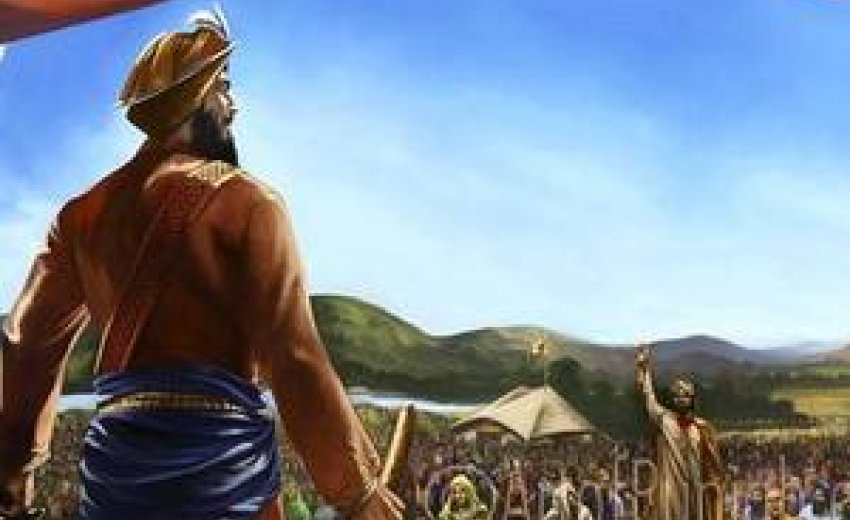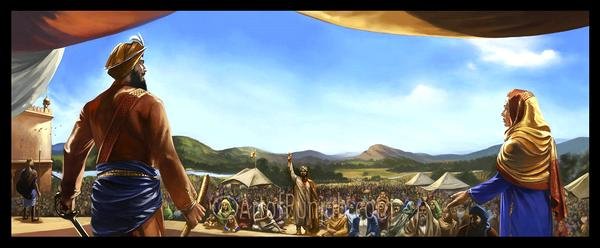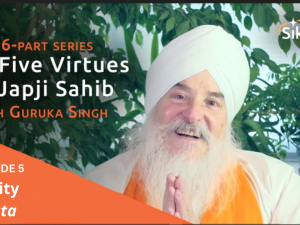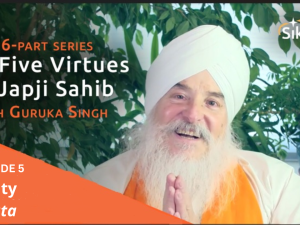 Vaisakhi is the most festive day for the Sikhs and is usually celebrated all over the world on the 13th and 14th April annually. This unique occasion marks the establishment of the Khalsa Panth and the idea of creating a universal brotherhood and a casteless society. It is founded on the principle of wishing good to all (sarbhatt da bhalla) and equality of all human beings (manas ki jaat sabhe eke pahchanbo).
Vaisakhi is the most festive day for the Sikhs and is usually celebrated all over the world on the 13th and 14th April annually. This unique occasion marks the establishment of the Khalsa Panth and the idea of creating a universal brotherhood and a casteless society. It is founded on the principle of wishing good to all (sarbhatt da bhalla) and equality of all human beings (manas ki jaat sabhe eke pahchanbo).
As this celebration falls in the month of Vaisakh, it was called Vaisakhi, a joyous month of harvest in the Panjab. The occasion has both historical and religious significance. In 1699, as everyone recalls, Guru Gobind Singh bestowed the Sikh community with a new image and a new identity as the Khalsa, the brotherhood of the pure ones. Anandpur Sahib is the blissful place to be during this time of year to join in with the sangat to partake of the Amrit.
Three years ago, I arrived in Anandpur Sahib a few days before Vaisakhi and stayed with a family who never have left AnandpurSahib and do not intend to. They are content there and and feel the grace and presence of Guru Gobind Singh Ji.
On the day of the Vaisakhi, I heard the sweet melodious kirtan from Takhat Sri Keshgarh Sahib and I made my way down to the shrine. It is located in a very serene, tranquil and strategic spot,overlooking miles of sprawling fields and the breathtaking Sivalik Hills.
On this occasion I felt very different: full of fervour and energy. I wanted to receive the Amrit and I approached the sewadars to offer my head. They allowed me to enter the room that was thronged with women and men waiting patiently to receive the Amrit.
I walked through the crowd and sat in front of the Amrit bowl. The Panj Piyares (Five Beloved Ones) started the divine process of the Panj Baniyian (the five daily prayers - Japji Sahib, Jaap Sahib, Swaiyyas, Benti Chaupai and Anand Sahib) and they were taking turns stirring the Amrit with the same khanda (long double edge sword) which Guru Gobind Singh Ji himself used to transform others as well as himself.
It was incredible.
As I sat peacefully, yet filled with joy, I was able to imagine what happened there in 1699. I was so overjoyed when I was first given the Amrit and the Amrit was sprinkled over my kesh, I was asked to utter ‘Waheguru!’ ‘Waheguru!’ after every sprinkle and sip. It was an experience to be remembered forever, and it was Guru Ji’s Grace to be there.
A couple of my friends who came with me just stood back and watched. They were not prepared to make the decision to take this great step of transformation.
Perhaps they were not destined to receive the Amrit. But perhaps they shall do so in the future! It is an experience to cherish and live with forever. The whole idea of the Amrit ceremony is to abide by it and live within its rehat maryada or rules of conduct. It is also useful to have the historical background of the creation of Khalsa, The Pure Ones, to give it real meaning and significance.
The Creation of the Khalsa
After prolonged meditation, with deep understanding of the life, work and experiences of the Sikh Gurus before him; understanding of the the history, the prevailing conditions India and the policies of the Mughal Empire, and also a clear vision of the future, Guru Gobind Singh decided to take the Guru tradition and the long struggle of the mission of the Gurus to an unprecedented place. With the sacrifice of his four sons consciously made to ensure that the Guruship would continue as a legacy and not as a lineage, he announced his decision to hold a massive congregation of followers from all over the country at Anandpur Sahib. His intent - to make manifest the reality that the Shabd Guru is within us all and that we would no longer bow to any man, but only to the Shabd Guru.
The congregation was arranged in April 1699 on the first day of Vaisakh month by sending orders to Sikhs everywhere and asking them to invite others.
Around 80,000 people gathered that day. A stage was set up on the site of today’s Takhat Keshgarh Sahib. After singing of hymns, Guru Ji, who was fully attired as a warrior, brandished his naked sword and announced “I need the head of a Sikh!”
The congregation fell silent. ‘What has come over our Guru?’ thought one and all. After some time, a man named Bhai Daya got up and presented himself before the Guru. He was of warrior caste (khatri) and was from Lahore. The Guru took him into the tent which was pitched at the back. He came back with his sword dripping with blood and asked for another head. Dharam Chand, a Jat from Hastinapur arose and offered his head. Guru Ji patted him on the back and took him into the tent. Then the Guru returned and demanded a third, a fourth and a fifth head.
Some members of the congregation arose and left in fear. After Mohkam Chand, who belonged to the caste of washerman from Dwarka, Himmat Rai, a fisherman of Jagannath, and Sahib Chand, a barber from Bidarpur offered themselves, some went and complained to Mata Sundari about the Guru’s behaviour.
After attiring all of them in robes and weapons, the Guru brought them all before the assembled Sangat and called them his Five Beloved or Favourites (Panj Piyare.) He prepared a bowl of holy nectar, the amrit, by chanting the five sacred prayers while stirring the amrit in a steel bowl with the two-edged dagger. Guru Ji’s wife added sugar crystals (patashaas) to the amrit. Steel to bring strength, water for purity, bani for transformation and sugar for sweetness and humility.
He offered the amrit to all of the five and announced that henceforth Daya (compassion) Singh, Dharam (duty and righteousness) Singh, Mohkam (valour) Singh, Himmat (courage) Singh and Sahib (mastery) Singh shall be known as the Five Favourites who will protect the sufferers, will fight against oppressors like lions and will eliminate tyranny.
Then the Guru himself turned to the Five Beloved Ones and begged them to initiate him into the Khalsa. Thus he became "the disciple Guru". Although he was their Guru he made himself their disciple; “Waho Waho Gobind Singh, apay Guru chela.”
Shedding their caste ties, he made Sikhs into "Singhs" (lions) and the women, he called "Kaur" (lionesses or princesses) By calling the gathering of Sikhs the Khalsa (pure ones), he gave birth to an army of saint-soldiers whose mission was to eliminate oppression and injustice and to create a society filled with spiritual peace, the unity of humankind and a feeling of togetherness.
Guru Gobind Singh Ji said: Where there are Panj Piyares, there I am. When the Five meet they are the holiest of the holy.
Vaisakhi marks the beginning of the harvest in Panjab and it also marks the anniversary of the creation of the Khalsa which embodies the qualities of courage, love and faith.
Upon initiation, the Sikhs agreed to keep the Five K’s or kakkars. The first of this is Kesh or uncut hair, which men tend to tie in a knot and keep it neatly under their turbans. The hair has strength and represents unity with the natural order. A Khanga, or a small wooden comb enables the person to keep the hair clean and tidy, representing clarity and respect for the Creator’s Creation. The Kara, an iron bracelet, signifies strength and is made in the form of a circle indicating the Infinite nature of God. It is usually worn on the right wrist to remind us to act consciously at all times. The undergarment or cotton breeches is called Kaachhera and it represents modesty and restraint. The Kirpan (The root of the word kirpan is "kirpa" which means grace) is a small sword which is worn to restore grace or defend grace and is also used to purify karah prashad or degh (the sweet pudding served to all that signifies the Guru’s blessing) as well as the food which is to be served in the Langar (communal meal.)
The creation of the Khalsa also signified the end of caste, creed and religious differences and the birth of a New Man – a man of Universal Consciousness.
On that occasion Guru Ji said:
"Chunkar az hama heelate darguzasht,
Halal ast burdan bshamshir dast."
(Only after all other means have failed is it just to draw the sword.)
Guru Gobind Singh Ji created the Khalsa, and Khalsa was his own life.
As he said, The Khalsa is my True Guru (Khalsa mero Satguru poora.)
With the creation of the Khalsa, there came a set of rules to adhere to in order to give focus and vision. These ‘principles of living’ were created to preserve Sikhi, the the lifestyle of the Khalsa.
Guru Gobind Singh Ji is a great inspiration to others. His humble teachings expressed the Oneness of mankind, love and worship of the Infinite in All people and things, self-awakening, freedom from attachment, valour and service to all – consciously taking responsibility for the welfare of others. He lived the life of a saint-soldier, combining love and devotion with courage and strength.
The whole life of Guru Gobind Singh exemplified “chardhi kala” (perpetual optimism and high spirits.)
He beautifully proclaimed:
Chiron se main baz turaun; sawa lakhse ek laraun. Tabe Gobind Naam Kahaun
(I have turned sparrows to hawks. A single Singh can triumph over a hundred thousand in battle. Then alone can I call myself Gobind Singh.
Guru Ji also inspired others and asked others to humbly greet their fellow human beings by saying “Waheguru Ji ka Khalsa Waheguru Ji ki Fateh, meaning The Khalsa belongs to God and all victories are His.
Raj Karega Khalsa! (The pure of heart will rule the world.)






